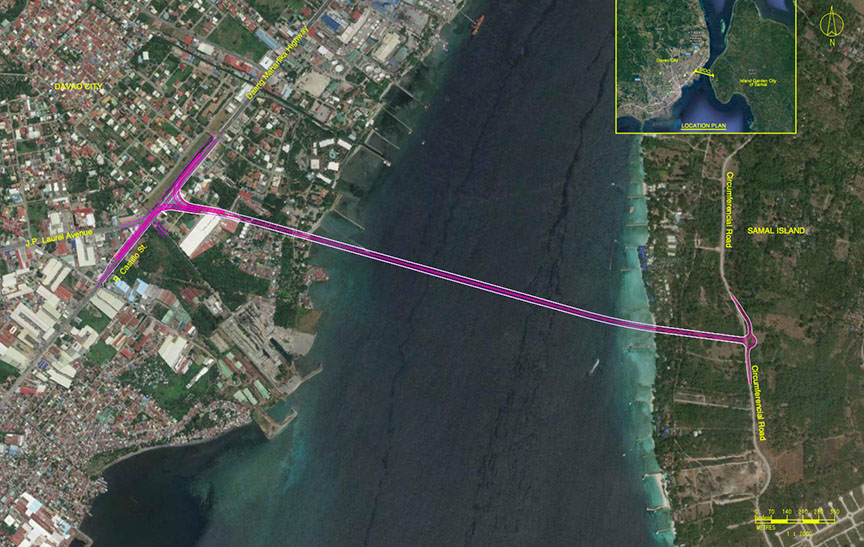‘Build the bridge but preserve the reef’
DAVAO CITY (MindaNews / 26 Oct) – The president of Ateneo de Davao University (ADDU), Fr. Joel S. Tabora, urged the government Wednesday to put realign the highly anticipated Samal Island-Davao Connector (SIDC) project, or more commonly known as the Davao-Samal Bridge, so it would not damage the Paradise Reef.

Tabora said in a statement released a day before the groundbreaking of the multi-billion SIDC project that environmental advocates are not against the construction of the bridge but added that the government should take into consideration the coral reef that may suffer from irreversible damage should the approved alignment be pushed through.
President Ferdinand Marcos Jr. is expected to attend the groundbreaking on Thursday.
“But where there are clear alternatives to destroying Paradise Reef by building the bridge to land in the Costa Marina Beach Resort, here we take a stand for the environment. Build the bridge, but preserve the Paradise Reef,” he said.
Tabora said that in the construction of the SIDC project, the government must be mindful of the preservation of Paradise Reef “for its value in itself, for the joy it can bring to ourselves and our children, and for the glory it gives to our Creator God.”
Last June 13, Chinese Ambassador to the Philippines Huang Xilian exchanged with then Finance Secretary Dominguez the signed Framework Agreement and Loan Agreement worth $350 million or P18.67 billion for the bridge.
The Paradise Reef is a 300-meter contiguous reef situated on the coast of the Costa Marina Beach Resort and adjacent Paradise Island Park & Beach Resort in Barangay Caliclic, Babak District of Island Garden City of Samal (IGACOS).
The Rodriguez family, who operate both resorts, opposed the current alignment of the SIDC as it would destroy the Paradise Reef, a “hidden treasure of Samal” considered by conservationists as an important “gene bank” of marine creatures.

“Whether we are from government, the private sector, or academe, the environmental crisis in the world – signaled by global warming, climate change, extreme weather, hurricanes and floods, wildfires and drought, the loss of biodiversity on land and in the oceans – necessitates that we stand back from the ‘most efficient way’ of doing things in order to take a stand for the environment,” Tabora added.
He lamented how people destroy the environment in the name of progress, allowing it to be “dirtied, abused, ruined or destroyed.”
“Like the Paradise Reef between Samal and Davao, I have seen its yellow scroll coral, its massive brain coral, its tiered table coral. I have seen the giant clams, the red-orange starfish, and all manner of colorful tropical fish thriving in and around the coral. All treasures one would not even know are there if all one sees is surface,” he said.
Tabora said that no less than Pope Francis himself considered the environment – the common home – as the “most oppressed” in the world today.
“Pope Francis insists that all species created in their uniqueness by a loving God have ‘value in themselves.’ When we allow them to be destroyed or to go extinct, they can no longer give us and our children breathtaking joy,” he said.
Citing the Pope, Tabora encouraged the public to take a stand for the environment.
Tabora added that “progress” has been responsible for the loss of biodiversity, the sources of extremely important resources such as curing diseases and industrial materials.
He said that corals are regarded as the rainforests of the oceans, the sites of spawning for countless fish that are of use for the “food sufficiency” of human beings.
Last October 5, the family questioned the lack of prior consultation for the construction of the project, saying the present “alignment was chosen in a workshop in Manila without the participation of local landowners and stakeholders.”
They said that the environmental clearance certificate (ECC) for the SIDC Project was issued without a prior Protected Area Management Board (PAMB) clearance.
But the Department of Public Works and Highway (DPWH) said that the PAMB issued a resolution in October 2020, “giving clearance or expression of support for the SIDC Project.”
Contrary to DPWH’s claim that the Samal landing site is outside a protected area, the Rodriguez family said the entire Samal Island remains a protected area and was, in fact, established as a Mangrove Swamp Forest Reserve under Proclamation No. 2152, S. 1981, an initial component of the National Integrated Protected Areas System.
“The law requires an act of Congress to disestablish a protected area or modify its boundary. The DPWH has not come forward with any such evidence insofar as Samal Island is concerned,” the family said. (Antonio L. Colina IV / MindaNews)



No comments:
Post a Comment